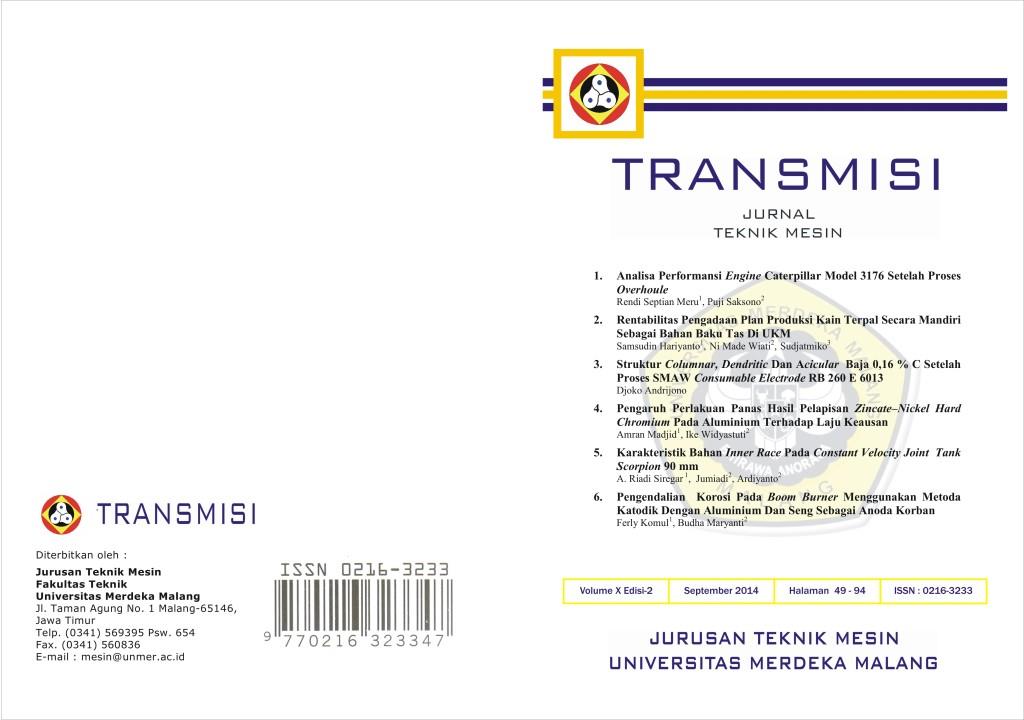PENGARUH PERLAKUAN PANAS HASIL PELAPISAN ZINCATE–NICKEL HARD CHROMIUM PADA ALUMINIUM TERHADAP LAJU KEAUSAN
DOI:
https://doi.org/10.26905/jtmt.v10i2.4615Keywords:
Laju Keausan, Temperatur Aging, Zincate-Ni Hard ChromiumAbstract
Pelapisan zincate-Ni Hard Chromium plating pada Aluminium bertujuan untuk meningkatkan kekerasan dari logam induk (pelapisan rekayasa) yang pada akhirnya dapat digunakan untuk meningkatkan ketahanan aus material. Lama waktu pelapisan berpengaruh terhadap ketebalan hasil lapisan deposit dengan bertambahnya ion-ion logam yang terdeposisi, sementara pemanasan dilakukan dengan tujuan untuk meningkatkan kekerasan dengan melalui proses aging sehingga akan meningkatkan ketahanan aus atau menurunkan laju keausan material. Laju keausan material akan mengalami penurunan pada proses dengan pemanasan temperatur aging 2000C hingga 12%-25%. Hal ini disebabkan karena terbentuknya presipitasi pada hasil lapisan yang meningkatkan kekerasan. Namun apabila temperatur terus ditingkatkan hingga 4000C yang terjadi adalah peningkatan laju keausan atau penurunan ketahanan aus bahan, yang disebabkan karena terjadinya pertumbuhan butir atau pengkasaran butir logam.Downloads
References
Anton J Hartono, Tomijiro Kaneko, 1993, Mengenal Pelapisan Logam, Penerbit Andi Offset. Yogyakarta.
Frederick A. Lowenheim, 1909, Modern Electroplating, London.
J.K. Dennis, T.E. Such, Nickel and Chromium Plating, London-Newnes Butter Worths.
Johan Nurdiyanto, 2007, Analisa Pengaruh Variasi Waktu Elektroplating Hard Chromium, Zincate Hard Chromium dan Zincate–Nikel Hard Chromium Pada Aluminium Terhadap Sifat Keausan, Fakultas Teknik Jurusan Mesin Universitas Merdeka Malang
J.J More, 1981, Chemical Metallurgy, Butterwoth and Co (publisher)Ltd.
Sidney H.Anver, 1987, Introduction to Phisical Metallurgy, Second Edition, MC.Graw Hill International, Singapore.
William F. Smith, Principles Of Materials Science And Engineering, McGrawHill Publishing Company
Downloads
Published
Issue
Section
License

This work, is licensed under a Creative Commons Attribution-NonCommercial-NoDerivatives 4.0 International License.
Authors who publish with this journal agree to the following terms:
- Authors retain copyright and grant the journal right of first publication with the work simultaneously licensed under a Creative Commons Attribution-NonCommercial-NoDerivatives 4.0 International License. that allows others to share the work with an acknowledgment of the work's authorship and initial publication in this journal.
- Authors are able to enter into separate, additional contractual arrangements for the non-exclusive distribution of the journal's published version of the work (e.g., post it to an institutional repository or publish it in a book), with an acknowledgment of its initial publication in this journal.
- Authors are permitted and encouraged to post their work online (e.g., in institutional repositories or on their website) before and during the submission process, as it can lead to productive exchanges and earlier and greater citation of published work.




